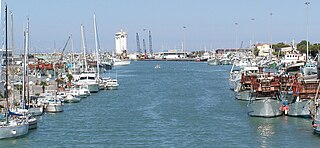
The Port of Singapore is the collection of facilities and terminals that conduct maritime trade and handle Singapore's harbours and shipping. It has been ranked as the top maritime capital of the world, since 2015. Currently the world's second-busiest port in terms of total shipping tonnage, it also transships a fifth of the world's shipping containers, half of the world's annual supply of crude oil, and is the world's busiest transshipment port. It was also the busiest port in terms of total cargo tonnage handled until 2010, when it was surpassed by the Port of Shanghai.

Gioia Tauro is a comune (municipality) in the Metropolitan City of Reggio Calabria (Italy), on the Tyrrhenian coast. It has an important port, situated along the route connecting Suez to Gibraltar, one of the busiest maritime corridors in the world.

Chennai Port, formerly known as Madras Port, is the second largest container port of India, behind Mumbai's Nhava Sheva. The port is the largest one in the Bay of Bengal. It is the third-oldest port among the 13 major ports of India with official port operations beginning in 1881, although maritime trade started much earlier in 1639 on the undeveloped shore. It is an artificial and all-weather port with wet docks. Once a major travel port, it became a major container port in the post-Independence era. An established port of trade of British India since the 1600s, the port remains a primary reason for the economic growth of Tamil Nadu, especially for the manufacturing boom in South India, and has contributed greatly to the development of the city of Chennai. It is due to the existence of the port that the city of Chennai eventually became known as the Gateway of South India.

The Port of Savannah is a major U.S. seaport located at Savannah, Georgia. As of 2021, the port was the third busiest seaport in the United States. Its facilities for oceangoing vessels line both sides of the Savannah River and are approximately 18 miles (29 km) from the Atlantic Ocean. Operated by the Georgia Ports Authority (GPA), the Port of Savannah competes primarily with the Port of Charleston in Charleston, South Carolina to the northeast, and the Port of Jacksonville in Jacksonville, Florida to the south. The GPA operates one other Atlantic seaport in Georgia, the Port of Brunswick. The state also manages three interior ports linked to the Gulf of Mexico: Port Bainbridge, Port Columbus, and a facility at Cordele, Georgia linked by rail to the Port of Savannah. In the 1950s, the Port of Savannah was the only facility to see an increase in trade while the country experienced a decline in trade of 5%. It was chaired and led by engineer Dr. Blake Van Leer.
The Port of Algeciras is the port and harbour of Algeciras, a city located in the province of Cádiz in the autonomous community of Andalusia, Spain. It is a commercial, fishing and passenger port. Primarily a transshipment port, its position near the Strait of Gibraltar and key east–west shipping routes establishes it as one of the busiest transshipment hubs in the world. It competes with Tanger-Med for the local transshipment market. It consists of numerous maritime infrastructures scattered throughout the Bay of Gibraltar. Although only the town of Algeciras and La Línea de la Concepción overlook the bay, there are port facilities in the rest of the bank, also belonging to the municipalities of San Roque and Los Barrios. It is managed along the port of Tarifa by the Port Authority of Algeciras Bay.

The Port of Haydarpaşa, also known as the Port of Haidar Pasha or the Port of Istanbul, is a general cargo seaport, ro-ro and container terminal, situated in Haydarpaşa, Istanbul, Turkey at the southern entrance to the Bosphorus, near Haydarpaşa Station. It is operated by the Turkish State Railways (TCDD) and serves a hinterland which includes the country's most industrialised areas.

The Port of Genoa it is one of the most important seaports in Italy, in competition with the ports of Marseille and Barcelona in the Mediterranean Sea. With a trade volume of 51.6 million tonnes, it is the busiest port of Italy after the port of Trieste by cargo tonnage.

The Port of Naples, a port located on the Western coast of Italy, is the 11th largest seaport in Italy having an annual traffic capacity of around 25 million tons of cargo and 500,000 TEU's. It is also serves as a tourist hub, servicing an estimated 10 million people annually transiting through the port.

The Port of Livorno is one of the largest Italian seaports and one of the largest seaports in the Mediterranean Sea, with an annual traffic capacity of around 30 million tonnes of cargo and 700,000 TEU's.

The Port of Valencia is a seaport in Valencia, Spain. It is the fifth busiest seaport in Europe and the busiest port in the Mediterranean. As of 2019, it moves an annual cargo traffic of around eighty-one million tonnes and 5.4 million TEU, ranking first in Spain and second in the Mediterranean basin in container shipping, and second in Spain in annual cargo traffic, after the Port of Algeciras.

The Port of Tokyo is one of the largest Japanese seaports and one of the largest seaports in the Pacific Ocean basin having an annual traffic capacity of around 100 million tonnes of cargo and 4,500,000 twenty-foot equivalent units.

Port of Tanjung Priok is the busiest and most advanced Indonesian seaport, handling more than 50% of Indonesia's trans-shipment cargo traffic. The port is located at Tanjung Priok, North Jakarta, which is operated by Indonesian state owned PT Pelindo. The port loaded and unloaded 6.2 million, 6.92 million, and 7.8 million TEUs of cargo during 2016, 2017 and 2018 respectively, out of a total capacity of about 8 million TEUs. The container port ranked as 22nd busiest in the world by Lloyd's One Hundred Ports 2019.

The Port of Colombo Sinhala: කොළඹ වරාය, Tamil: கொழும்பு துறைமுகம் is the largest and busiest port in Sri Lanka and the Indian Ocean. Located in Colombo, on the southwestern shores on the Kelani River, it serves as an important terminal in Asia due to its strategic location in the Indian Ocean. During the 1980s, the port underwent rapid modernization with the installation of cranes, gantries and other modern-day terminal requirements.

The Port of Cork is the main port serving the South of Ireland, County Cork and Cork City. It is one of the three "Ports of National Significance " as designated by National Ports Policy.

The Port of Gioia Tauro is a large seaport in southern Italy. It is the largest port in Italy for container throughput, the 9th in Europe and the 6th in Mediterranean sea. Located north of the city of Reggio Calabria, between the municipalities of Gioia Tauro and San Ferdinando, Calabria, it is close to the East–West route which stretches from the Strait of Gibraltar to the Suez Canal and serves mainly as a transshipment hub, connecting the global and regional networks that cross the Mediterranean.

Port of Baku is a sea port located in the Bay of Baku, on the coast of city of Baku, Azerbaijan. The main entrance faces the Neftchiler Avenue.

The port of Pescara is an Italian port on the Adriatic Sea at the mouth of the River Pescara in the city of Pescara.

Lekki Deep Sea Port, operational, but still partly under construction, is a multi-purpose, deep sea port in the Lagos Free Zone.

Contship Italia Group is an Italian container terminal, intermodal & logistics operator.
Apapa Port Complex also known as the Lagos Port Complex is Nigeria's largest and busiest port complex. The complex consist of a number of facilities including Apapa quays, Third Apapa Wharf Extension, Apapa Dockyard, Apapa Petroleum Wharf, Bulk Vegetable Oil Wharf, Ijora Wharf, Kirikiri Lighter Terminal, and Lily pond inland container terminal. Financed and built by the colonial government of Nigeria, It became the nation's busiest port for exporting agricultural produce from the provinces of Western and Northern Nigeria in the late 1920s. Administration was transferred to the Nigerian government upon the granting of self-government and In 2005, the complex was divided into terminals and contracted out to private operators with NPA acting as the landlord and regulator.


















